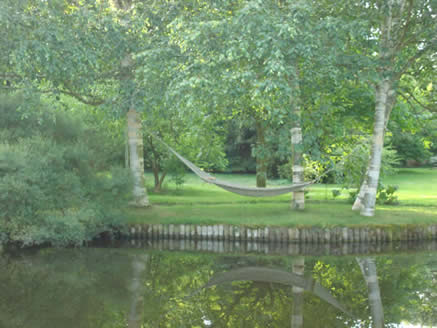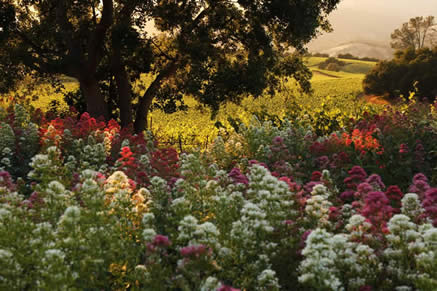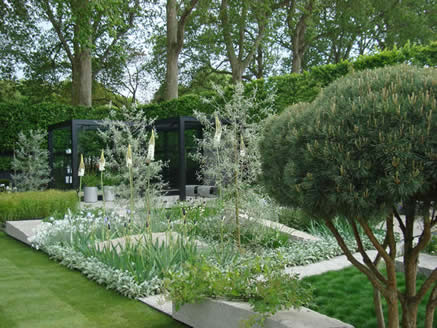Hanging the hammock
15 June 2009
‘Betula’ Schilling would not be amused. He has given me a dressing down in the past when I have admitted to peeling birches.
The man who taught us an important part of what we know about this delectable genus, hunting them up into the Himalayas to determine how much or little, and how consistently, their variety of coloured bark and shape of leaf change with geography, feels strongly that each layer of the papery skin is vital to the tree. Only the tree should decide when to slough it off. Meanwhile it should hang in peeling shreds and blow in the wind like a scarecrow’s jacket.
On the other hand, to the older gardener who haunts the West End less than he did, peeling birches makes a satisfying form of strip tease. Off comes the dingy outer layer, mossy and stained, volunteering itself with snags and loose ends, appealing to be peeled; yielding, though, only in modest ribbons, that sometimes girdle the tree but more often stop coyly just as it gets exciting.
Guiltily, aware of Tony Schilling’s disapproval, I look for another snag, a lifted corner of bark to take hold of. Peeling away it reveals the laundered
Passing Go
7 June 2009
We had a wedding in the garden on May 31st 2003, a day that turned out to be the hottest on record for May in the South East. Kitty, the bride, glowed in the sunshine, and so did all her friends. Her garden-obsessed father was probably the only one looking round in vain for flowers, let alone roses. Not even the precursors, the yellow Cambridge rose or the Maigold on the south wall were out.
Last Sunday was May 31st, and the puzzle was finding a rose that was not in full bloom, or even going over. The borders were brimming. Campanulas, the first daylilies, to my surprise anchusas from last year, startlingly blue, oriental poppies, geraniums, aruncus, valerian, catmint, pinks, speedwell, deutzia and indigofera, tradescantia, alliums, iris sibirica, philadelphus and honeysuckle, phlomis and penstemons were all flowering or beginning to flower. And as for the roses, the trusses on generous Floribundas (are you still allowed to call them that?), were stooping to the ground.
Calm down
1 June 2009
I was on the point of adding, as an afterthought to my piece the other day about my brother’s Italian garden, a eulogy on valerian, when a friend in California sent me a photograph I simply have to let you see. Here it is: Molly Chappellet’s garden on Sage Canyon Road at St. Helena in the Napa Valley. Nothing but valerian, with one of California’s best Cabernet vineyards below and beyond.
‘Valerian’ is Centranthus ruber, a woody-based perennial found all round the Mediterranean with flowers that can be brick red, white, pink or purplish; each plant is different and seed seems to come true. I’m not sure why it has such powerful associations with summer and stony places; perhaps because it can become so rampant. Its great moment is late spring. The other day I was admiring the stone wall along the road at Iford Manor near Bradford-on-Avon, where it almost hides the stones with warm soft colour.
The People's Choice
27 May 2009
Most conversations about Chelsea, after the Show, start with ‘Which garden did you like best?’ This year there seemed to be more consensus than usual. The judges’ difficult task was made easier by fewer and generally less ambitious gardens. The winner, Ulf Nordfjell’s Daily Telegraph garden (it seems to be The Telegraph’s year, one way and another) was uncontentious, pleasing, relaxing and idiomatically modern without startling colours or textures. I don’t want a black metal cube for a garden house (it reminded me of House & Garden in the ‘60s) but how can I take exception to those who do?
‘Light’, said Nordfjell, ‘is the most important thing’. At the light end of his garden he used greys, white, some blue and a little purple, with blocks of pale stone on which shadows could play (when the sun came out). In the centre, where light sparkled on moving water, the principal colour was green. At the shady end he used clipped hornbeam, graceful Cornus kousa and Rosa mutabilis, the only pink or red note.
Voting for the People’s Choice, as distinct from the judges’, preferred Robert Myers’s curvaceous abstract plot for Cancer Research, which seemed to me rather underplanted; so much white stone was on display that you needed sunglasses. Among the small gardens the Plasticine Paradise was the unsurprising winner. Did you know they made it in such powerful colours these days?
My concern, this year and every year, didn’t apply to the plasticine entry. It is
No reprieve
18 May 2009
It has taken me many years of patiently peeling ivy from my trees to discover the best way to do it. The obvious way, prising part of the woody stem from the bark and pulling, only results in broken ivy and the chore of chipping off the fragments.
The technique: detach just enough of the
|

shirt, immaculate and creamy, smooth and slightly waxy to the touch. Under the shirt, glimpsed only where it tears, is the tree’s bare skin, flesh-coloured,not ready yet to be bared to the light. Tempting, though.
Yesterday we ceremonially hung the hammock; the symbolic act that declares the summer open. (When we will have time to use it is an unanswered question.)
Last year we slung it between two larches near the summerhouse and the water garden. This year we went further afield, to the little promontory into the pond we call the Red Sea (a long story, that) where four white-trunked Betula ‘Jermyns’ are reflected in the water. Watching the two companionable carp in their calm cruising is my favourite pursuit. Now the hammock hangs between two of the birches, with a third within a short arm-stretch to push off for a gentle swing – or to find a loose end of bark to peel.
Felicia, Iceberg, Cornelia, Buff Beauty, Danae and Autumn Delight all need heavy-duty support. Comte de Chambord and Jacqueline Dupré, Chapeau de Napoléon and William Lobb have sprawled into thalictrums and goat’s beard and a forest of macleaya. A week of warm weather has brought us from a promising spring to high summer without passing Go.
What conditions conspired to give us this feast? Mainly, I think, the steadily rising temperatures and timely rain since February, when we had our only, and brief, cold spell. In January the thermometer went down to 21° Fahrenheit, in February (on the 10th) to 29° F, but the last time it fell below 40° F was at the end of March. In April it reached 65° and the range in May was from 40° to 70°.
There was plenty of rain. I’ll do it in millimetres (the more accurate measure, just as Dr Fahrenheit’s scale is for temperature). There was 60 mm in January, another 60 in February, 40 in March, 20 in April and 30 in May. At the beginning of June, in fact, we had had half our annual average: not an exceptional score, but judging by the results exactly the right amount. No one can say what combination of temperatures and moisture makes the winning formula; this one worked, though. I’m inclined to believe the secret is lack of extremes – just as it is the secret of our British climate. Yet many flowers are conceived, as it were, by conditions in the previous year. Did generous summer rain help?

My brother grows it with panache, but the prize has to go to Molly Chappellet’s valerian field. Turn the other way in her inspiring garden and you will see half an acre of Salvia turkestanica.
‘Valerian’ (from Latin valere) refers to its use as a medicinal herb, sovereign, apparently, in cases of nervous hysteria. Or perhaps it was just the soothing sight of it.

the judging of gardens frozen at a moment (and an entirely artificial moment) in time. They don't have plants that have just gone over, and nobody asks what you are expected to enjoy after the current display. You can’t, I know, expect judges to give points for things (plants yet to flower, for example) they can’t see. But gardening is as much about the passage of time as music is about measuring and dividing it. Gardening is essentially a process with no fixed conclusion. Not even the cycle of the seasons brings you back to precisely where you were before: substance, girth, patina change; light and shade reveal and conceal different facets; the gardener accepts many things that are beyond his control – loves them indeed, for adding effects beyond the reach of his imagination.
So what is your criterion for judging such disparate and ever-changing creations? The only answer I can give is the mood they evoke.
It seemed to me there was more sculpture in the show than ever – certainly if you include metalwork of divers kinds and sometimes doubtful purpose. I’m delighted that so many purses apparently stretch so far; a far cry from the traditional gardener’s resource of scrounging cuttings. A sculpture is a sure way of fixing a mood. Whether it is one you want to wake up to every morning, spring, summer and winter, calls for careful thought.
ivy to get your hand round it (or for young stems your fingers) and pull it upwards, (or downwards), parallel to the tree. The little pads it uses to cling with can resist an outward pull, but not a pull in the direction they are growing, or have grown.
Spring, while they are growing, is the time to do it. Let no one persuade you ivy is good for trees, or looks anything but slovenly on them.
|